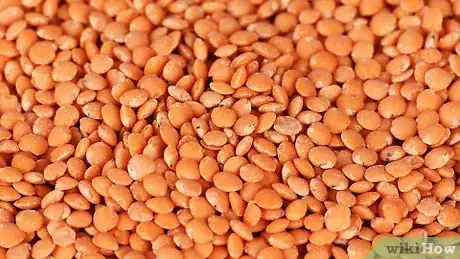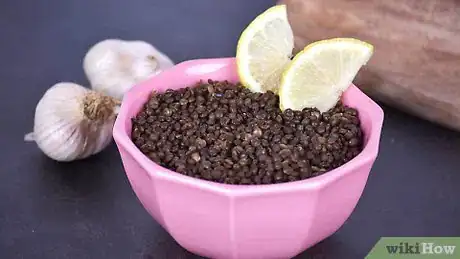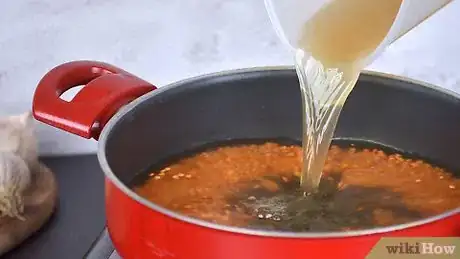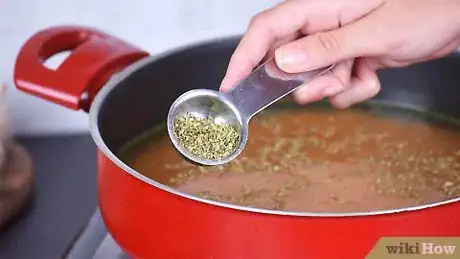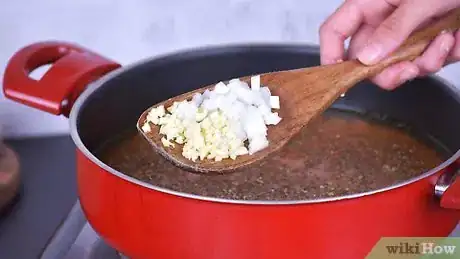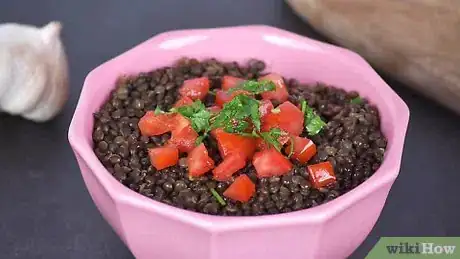This article was co-authored by wikiHow staff writer, Jessica Gibson. Jessica Gibson is a Writer and Editor who's been with wikiHow since 2014. After completing a year of art studies at the Emily Carr University in Vancouver, she graduated from Columbia College with a BA in History. Jessica also completed an MA in History from The University of Oregon in 2013.
There are 10 references cited in this article, which can be found at the bottom of the page.
The wikiHow Culinary Team also followed the article's instructions and verified that they work.
This article has been viewed 206,950 times.
Learn more...
Lentils might look like an unassuming legume, but they're a powerful pantry ingredient. They're high in protein and fiber while being low in calories. Green, brown, and red lentils have thin skins so they cook quickly and soften a lot. This makes them great for stews, thick sauces, or curries. If you'd like to make lentils that hold their shape, cook French or beluga lentils and serve them as a side or on a warm salad.
Ingredients
- 1 cup (200 g) of dried lentils
- 3 cups (710 ml) of water
- 1/2 teaspoon (3 g) of salt
Makes 4 servings
Steps
Selecting a Lentil Variety
-
1Pick green or brown lentils for fast-cooking lentils that soften a lot. These are probably the easiest lentils to find at the grocery store. They have thin skins so they cook fast, which is why they don't hold their texture. As you stir the lentils, they'll blend together into a purée that has a mild, earthy flavor.[1]
- Green and brown lentils are usually used in thick soups or stews, as a meat substitute in casseroles or pasta, or in dips and spreads.
-
2Buy French or Puy lentils if you want lentils that hold their shape. If you're looking for lentils that don't fall apart when they cook, choose grey-green French lentils which are also called Puy lentils. Since they keep their texture, use these if you want to scatter them over a warm salad, mix them with crumbled cheese, or serve them as a side dish.[2]
- These lentils have thick skin which is why they don't turn mushy. Because they're thick-skinned, they do take longer to cook than green or red lentils.
Advertisement -
3Try split red lentils for lentils that cook down into a puree. You've probably seen lentil curries in Indian and Middle Eastern cuisines. These lentils have a sweeter flavor than green lentils and they cook quickly. Because their skins are thin, they also soften and lose their texture.[3]
- Red, yellow, or orange lentils are great for puréed soups, thick sauces, and dal. You can even add lentil purée to baked goods for extra nutrition.
-
4Choose beluga or black lentils if you want tiny lentils with a firm texture. These small, round lentils have an earthy flavor like green or brown lentils, but their skin is a little thicker. This prevents the beluga lentils from breaking down as they cook. Beluga lentils work well with other earthy foods like mushrooms and leeks.[4]
- Keep in mind that if you overcook these lentils, they will turn mushy.
- You can also scatter these cooked lentils over salads or add them to soups where they'll give a little texture.
Cooking a Batch of Lentils
-
1Put 1 cup (200 g) of lentils into a strainer and rinse them with cold water. Set a fine-mesh strainer in the sink and put 1 cup (200 g) of any type of lentils into it. Look through them and pick out any shriveled lentils or tiny stones. Then, run cold water over the lentils to rinse off dirt or debris.[5]
- If you want to make a different amount of lentils, just use the ratio 1 part lentils to 3 parts water. For example, to cook 1/2 cup (100 g) of lentils, use 1 1⁄2 cups (350 ml) of water.
- 1 cup (200 g) of dried lentils makes 4 cooked servings.
-
2Pour the lentils into a pot with 3 cups (710 ml) of water. Choose a large pot since the lentils will double or triple in size once they've finished cooking. Then, set the pot on the stove.[6]
- Use cold water since hot water can soften the lentils before they cook, which might make them split or disintegrate.
- If you don't want to cook the lentils on the stove, put them into your pressure cooker with the water. It usually takes around 20 to 30 minutes for them to soften, but check your owner's manual for specific cooking times.
-
3Place a lid on the pot and bring the water to boil over high heat. Pay attention to when steam escapes from under the lid so you know when to turn the burner down.[7]
- Don't add salt to the lentils as they begin to cook or it will make the skins tough.
-
4Simmer the lentils uncovered over medium heat for 15 to 45 minutes. Turn the burner down to medium or medium-low so the water bubbles gently. Wear oven mitts to take the lid off of the pot and cook the uncovered lentils until they're tender. In general, simmer:[8]
- Green and brown lentils for 35 to 45 minutes.
- Red split lentils for 15 to 20 minutes.
- French, Puy, black, and beluga lentils for 25 to 30 minutes.
- Yellow lentils for 40 to 45 minutes.
-
5Drain the lentils if you're cooking firm varieties like Puy or black lentils. If you're making French, Puy, black, or beluga lentils, they won't absorb all of the water in the pot. To prevent them from becoming mushy, set a fine-mesh strainer in the sink and carefully pour the lentils into it so the water drains.[9]
-
6Serve the lentils or store them in the fridge for later. Since most lentils absorb the water, there's no need to drain them before you enjoy them. At this point, you can season your lentils with about 1/2 teaspoon (3 g) of salt or flavor them with your choice of seasonings.[10]
- Refrigerate leftover lentils in an airtight container for up to 4 days.
Customizing Your Lentils
-
1Replace all of the water with broth for a flavorful dish. There's nothing wrong with cooking lentils in water, but you can give the legumes a ton of flavor by using chicken or vegetable stock. Buy the broth or use homemade and substitute it for all of the water when you cook the lentils. They'll absorb the stock and become full of flavor.[11]
- You may want to cut back on the salt in your lentils or use a low-sodium stock so you can control the sodium.
-
2Add up to 1 tbsp (6 g) of dried spices to the water to season the lentils. Lentils have a very mild flavor on their own, but they absorb flavors if you add spices to the simmering water. You can use up to 1 tbsp (6 g) of a single spice or use your favorite spice mixture. Try:[12]
- 1 tsp (2 g) of dried oregano, 1 tsp (2 g) of dried parsley, 1/4 tsp (.5 g) of ground sage, and 1/4 tsp (.5 g) of onion powder for Mediterranean flavoring.
- 1 tsp (2 g) of ground cumin, 1 tsp (2 g) of ground turmeric, and 1/2 tsp (1 g) of red chili flakes to add an Indian flavor.
- 1 tsp (2 g) of paprika, 1 tsp (2 g) of cumin, 1 tsp (2 g) of ground ginger, 1/2 tsp (1 g) of turmeric, and 1/2 tsp (1 g) of cayenne pepper for spicy lentils.
-
3Put garlic, an onion, or other aromatics in the water for a deeper flavor. You don't need a lot of ingredients to add flavor to mild lentils. Toss 4 peeled and chopped garlic cloves into the water with the lentils before you cook them. Add 1 chopped onion and any other aromatics you like.[13]
- Add 1 to 2 bay leaves for a mild mint and pine taste or put a sprig of fresh rosemary or thyme into the cooking liquid for an herbal flavor. Remember to pull these out before you serve the lentils.
-
4Don't add acidic ingredients to the lentils as they cook or the skins will toughen. For Italian-style lentils, add chopped tomatoes to the warm lentils. You can also toss them with an oil and lemon vinaigrette for a burst of flavor.[14]
- If you want to brighten the taste of the lentils, stir a few drops of apple cider vinegar into them once they finish cooking.
Community Q&A
-
QuestionIs it okay to cook the lentils with a ham bone with some meat still on the bone? Does this alter the cooking time or methods?
 Deborah Ann CrowCommunity AnswerIt makes the lentils tougher because of the salt in the ham. You can add the ham after the lentils are done or nearly done, though. I learned from experience when I chopped ham and added it to the lentils while they were cooking. It made them tough and chewy. If it's a fresh ham (not cured), that would be different and I would use the ham bone while cooking.
Deborah Ann CrowCommunity AnswerIt makes the lentils tougher because of the salt in the ham. You can add the ham after the lentils are done or nearly done, though. I learned from experience when I chopped ham and added it to the lentils while they were cooking. It made them tough and chewy. If it's a fresh ham (not cured), that would be different and I would use the ham bone while cooking.
Things You'll Need
- Fine-mesh strainer
- Large pot or saucepan
- Spoon
References
- ↑ https://www.bonappetit.com/story/types-of-lentils
- ↑ https://www.bonappetit.com/story/types-of-lentils
- ↑ https://www.bbcgoodfood.com/glossary/lentils
- ↑ https://www.cookinglight.com/eating-smart/nutrition-101/what-are-lentils-healthy
- ↑ https://www.thekitchn.com/how-to-cook-lentils-on-the-stove-116321
- ↑ https://www.lentils.org/recipes-cooking/how-to-cook-lentils/
- ↑ https://youtu.be/thjD7aU9ZV4?t=26
- ↑ https://www.bbcgoodfood.com/glossary/lentils
- ↑ https://www.thekitchn.com/how-to-cook-lentils-on-the-stove-116321
- ↑ https://www.thekitchn.com/how-to-cook-lentils-on-the-stove-116321
- ↑ https://youtu.be/thjD7aU9ZV4?t=34
- ↑ https://www.lentils.org/recipe/mediterranean-spiced-lentils/
- ↑ https://www.cookingindex.com/recipes/62386/lentils-with-garlic-onion-madhur-jaffrey.htm
- ↑ https://youtu.be/Ez1z9zzOKdA?t=333
- ↑ https://www.bbcgoodfood.com/glossary/lentils
About This Article
To make lentils on the stove, start by rinsing the lentils under cool running water for 30 seconds. Then, place the lentils in a saucepan, add twice as much water, and heat the contents until the water comes to a rapid simmer. At that point, reduce the heat and simmer gently for 20 to 30 minutes. Afterwards, remove the saucepan from the stove and allow the lentils to stand for 5 to 10 minutes in order to fully absorb the water. Finally, place the lentils in a colander to drain out the excess water, and season with salt if desired. To learn more, including how to cook lentils in a slow cooker, scroll down.


